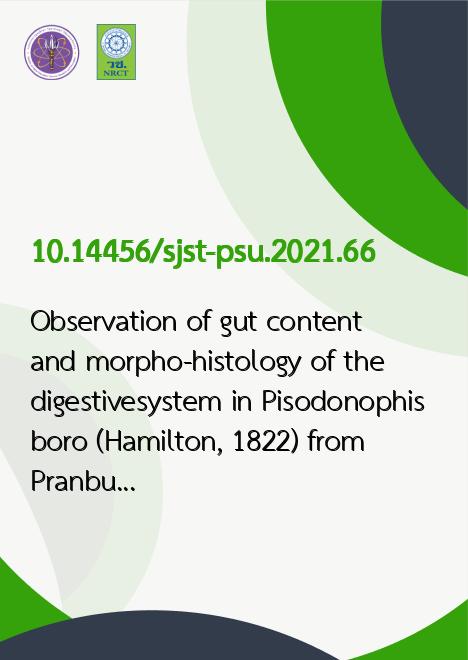
|
Observation of gut content and morpho-histology of the digestivesystem in Pisodonophis boro (Hamilton, 1822) from Pranburi RiverEstuary, Thailand |
|---|---|
| รหัสดีโอไอ | |
| Creator | 1. Phakorn Na Lampang 2. Amphornphan Palasai 3. Sinlapachai Senarat 4. Wannee Jiraungkoorskul 5. Jes Kettratad |
| Title | Observation of gut content and morpho-histology of the digestivesystem in Pisodonophis boro (Hamilton, 1822) from Pranburi RiverEstuary, Thailand |
| Publisher | Research and Development Office, Prince of Songkla University |
| Publication Year | 2564 |
| Journal Title | Songklanakarin Journal of Science and Technology (SJST) |
| Journal Vol. | 43 |
| Journal No. | 2 |
| Page no. | 496-504 |
| Keyword | gut content, microanatomy, Sarmatium germaini, optimum foraging theory |
| URL Website | https://rdo.psu.ac.th/sjstweb/index.php |
| ISSN | 0125-3395 |
| Abstract | The snake eel, Pisodonophis boro, is an important ecological and subsistence component of the Pranburi River estuary.Here, we used gut content analysis and morpho-histology to examine optimum foraging theory in P. boro in the Pranburi Riverestuary. Gut content analysis revealed that four species of crabs, including Metaplax elegans, Perisesarma bidens, Sarmatiumgermaini, and Uca perplexa, but S. germaini were consistently present at high levels in the gut throughout a year-long study. Theindex of relative importance showed that the most important prey was S. germaini. The overall anatomical morphology of thedigestive system of P. boro was elongated, and the stomach appeared as Y-shaped. The histology of the P. boro esophagus,stomach, and intestine were examined followed the standard histological techniques. Goblet cells through the digestive tract of P.boro were also seen among the epitheliums and reacted positively to periodic acid schiff and alcian blue staining methods.Overall, we suggest that P. boro is a specialist feeder on crabs rather than an opportunistic feeder. |
